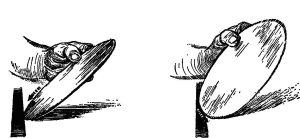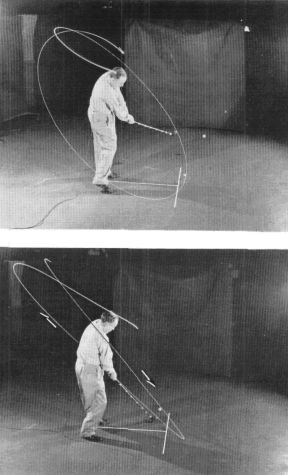| Free Golf Swing Tips, Techniques, and Golf Product Reviews! |
 |
|||||
The Golf Downswing and The Plane of the Golf SwingI n this section we analyse the plane of the golf swing. In the previous section dealing with the check points to a good golf downswing, we wondered why the movements involved are so difficult for many golf players to get. There are three main reasons for this:
The first and second of these reasons have been thoroughly covered in this and earlier sections of this site, but the feeling that you have to make the golf club head do something needs elaboration. This belief stems, actually, from a complete misunderstanding of the golf swing, and there are two reasons for the misunderstanding. "The average player has the almost overpowering conviction that if he hits the ball from inside this line it will fly far out to the right. He cannot see how anything else can happen."
The first thing people find hard to believe, apparently, is that a golf ball is driven straight by hitting it from the inside. The average player has the almost overpowering conviction that if he hits the ball from inside this line it will fly far out to the right. He cannot see how anything else can happen. He also knows that when he takes the club to the top of the golf backswing it is well inside this line. His first instinct, when he starts the club down, is to manipulate the head out onto the line or near it, so he can bring it down along the line and so knock the ball straight. When the player does this the first movement he makes takes his hands and the club away from his body. The instant they move away they get outside the plane they must be in to hit from the inside. The Plane of the Golf SwingBefore we go further, let's look at the plane of the golf swing. This is extremely important. If we understand it, learning the right action will be easier for you.
From the top of the backswing to a point near the end of the follow-through, the head of the club describes what we can call, for convenience, a circle. It isn't really a circle but that isn't important. Suppose we liken this circle to the rim of a wheel. Then we cover the wheel with skin, let's say, so it's like the head of a drum — with a hole in the center for our head to stick through. We now have a flat circular surface. That is what we call the golf swing plane. During the golf swing this plane inclines or leans toward the player from 25 to 40 degrees. The exact amount depends on the length of the club used and on whether the golf player is an upright or a flat swinger. The bottom of the circular plane touches the line of flight (may cross it slightly) at the ball, then comes back inside and goes on up into the follow through.
If that plane is twisted just a little (as seen in the picture to your right), the golf swing is thrown outside, and you can see how the club head, following the edge of this plane, now approaches the ball from outside the line instead of from inside. This might make more of an impression if you manipulate the plane yourself.Take a flat dinner plate (preferably not the best china in the house), hold it at an inclination to a straight line on the table. Now twist the plate a little, as shown in the illustration to the right, and see how little alteration it takes to bring the swing to the ball from the outside. It is just this "little bit" that we have to avoid when we swing a golf club. In this respect it is well to know, too, that at the top a very slight move by the hands forward, or toward the line of flight as they start down, moves the head of the club a comparatively great distance. A mere two inches by the hands moves the club head out a foot, throwing it outside. It is, as we say, already outside as it starts down. When you realize that this slight move of the hands is instinctive — you don't know you make it — then you can understand how hard a golf pro has to work to cure hitting from the outside.
|
Recommended Golf Swing |
|||||
Subscribe to My RSS/XML Feeder |
||||||
|
| Homepage | The Rules Of Golf Quiz | Golf Blog | Link to Us |
Copyright©
2006-20015 Golf-Swing-Magic.Com. All Rights Reserved. |
||||||



